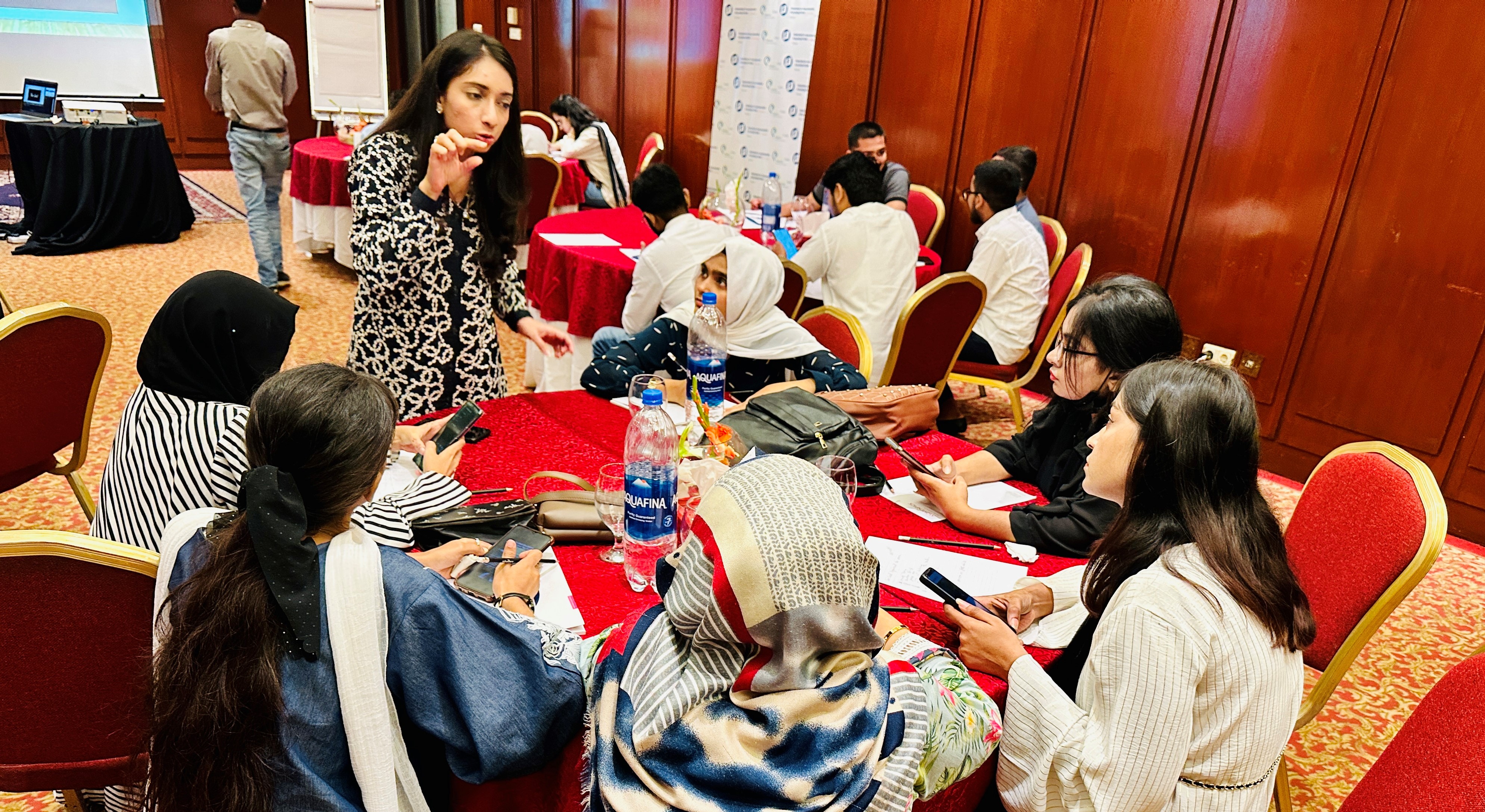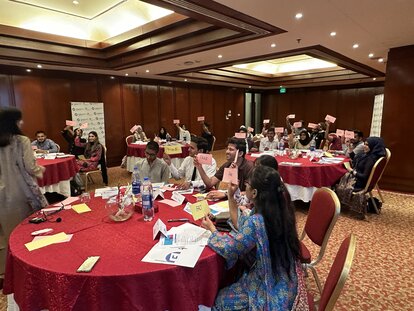IAF Gummersbach
Using Social Media Responsibly

Hawwa Fazal, (IAF Gummersbach Alumni) discussing various case studies with university students on how to identify fake news on digital platforms, Karachi 2023
© Friedrich Naumann Foundation for Freedom - PakistanLast month, former prime minister Imran Khan was unceremoniously arrested on allegations of corruption. Within hours of his arrest, a pre-recorded video message from Khan started circulating on social media in which the former premier told his supporters he had been arrested on false allegations, his life was in danger, and the arrest was part of a grand scheme of things to prevent him from doing the 'right thing'.
The video spread like wildfire leading to violent mass protests across the country -- all it took was a click on the retweet button.
Soon the hashtag #imrankhan was trending on Twitter with more than 200k tweets.
Another hashtag, "#نیکلو خان_کی_زندگی باؤ [come out save Khan's life]," was tweeted 1256.51K times.
However, no one seemed to realise just one minor problem: the video was published a year ago and was utterly unrelated to the recent chain of events.
Unfortunately, this is nothing new.
In fact, the spread of false news is a common occurrence in Pakistan's social media space, and a disproportionately large number of the victims of the wrong news mania are young people who lack media literacy. Not to say that social media always disseminates incorrect information. There is no denying that it can -- and has been -- used to bring change for the good of society.
For instance, in 2021, Shehri-CBE used social media to highlight the issues women face while using public transport in the biggest city of Pakistan, Karachi. (Dawn : Call to introduce women-only transport services in city ) They gathered over 1000 signatures, and journalists reached out to us to highlight the issue, leading to some discussions with stakeholders and voila! Today the bustling metropolis has a dedicated women's bus fleet. (Will Karachi’s pink bus finally break the glass ceiling or crash into it yet again? )The heroes that led to the success of this campaign were the youth on social media, who shared, liked and signed the digital petition!
For these reasons, banning or placing curbs on a channel where the Freedom of Speech has brought justice — could be disastrous.
Power without Literacy
Social media is a powerful tool, and together with Freedom of Expression at its helm, it has given ordinary citizens the power to become changemakers.
Pakistan has begun its laborious journey towards digitisation.
According to a report titled 'Digital 2023: Pakistan by by DataReportal', there were 87.35 million internet users in Pakistan in January 2023, while the country's internet penetration rate stood at 36.7 percent of the total population at the start of 2023.Moreover, Pakistan also had 71.70 million social media users by January 2023. However, the unprecedented and rapid explosion in social media use in Pakistan has left many young people vulnerable to online sexual harassment and the negative impacts of fake news and hate speech.
Social media is an internet-based form of communication used by everyone — from three-year-olds to 80-year-olds. In this time, who hasn't shared, liked and praised stories, memes or pictures without fact-checking them just because they came from someone familiar, even if vaguely so? Such unconfirmed dissemination can be disastrous, especially for the youth who spend hours on social media, using it as a tool to connect, learn, and share information.
The only way to control the spread of fake news and harassment on social media is to inform its most vulnerable users of the consequences. The youth must be made aware of the power they hold in the form of freedom of expression and a click on social media. But the task is monumental and demands immediate attention.
Tapping in from our learnings at the International Academy for Leadership (IAF) Germany of Friedrich Naumann Foundation for Freedom — Anjabeen and I pitched a workshop at the annual IAF alumni meetup in Pakistan and won.
Our idea was simple: teach the youth the importance of using their Freedom of Expression with Responsibility.
the spread of false news is a common occurrence in Pakistan's social media space, and a disproportionately large number of the victims of the wrong news mania are young people who lack media literacy

Participants identifying if the news shared by moderator is fake or not
© Friedrich Naumann Foundation for Freedom- Pakistan, Muhammad AnwarThe art and science of catching fake news: in practice
The workshop's target audience was university students who had just gained access to social media. As first-time users, who have just gained the power to formulate opinions, the young are bound to make mistakes before they finally realise their mistakes. We gave them a basic understanding of fake news, introducing them to the type of fake news on the internet; misinformation and disinformation. We also discussed why someone would make fake news and benefit from their engagement through users like them. Lastly, we taught them basic fact-checking tools to help them differentiate between fake news and real news.
Some of these tools were as follows:
- Lateral Reading: Read a fact or news across many connected websites instead of digging deep into the same source.
- Credibility of the source: If a piece of information is being delivered to you by someone, it is essential to determine if the person is reliable, which can be done by asking questions about their expertise, experience and conduct.
- Origination of the News: Before trusting information, it is crucial to question where the data is coming from. Does the source give out the correct information, or has it made mistakes in the past?
- Click Restraint: Do not believe the information on the top of the search bar could be wrong. Read the following three to four lines before making your opinion on the news.
- Look into the details: If you find a news piece that seems unrealistic, check the news authenticity — even if it is from a highly reputed publishing company. Screenshots are often used to spread fake news, so check its alignment, the spelling of words and the context of the information.
The workshop participants were then made to put these tools into practice through activities. The questions were designed to test their learning and ability to think critically before deciding to like, share or comment!
